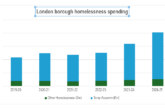The impact of Londoner’s lifestyles on the climate challenge continues to reduce each year, but there is still more work to do to have a fighting chance of meeting net zero targets, warns a new report by London Councils, ReLondon and the GLA.
Consumption-based emissions are calculated by allocating emissions to the final consumers in each country, and can illuminate the emissions associated with goods and services throughout their supply chain.
The report, commissioned by London Councils, ReLondon and the GLA, and carried out by the University of Leeds, showed that the average Londoners’ household consumption-based emissions have decreased by 49%, from 10.0 Mtonnes CO2e in 2001 to 5.1 Mtonnes in 2020. The 2008 financial crisis was the main cause of these reductions, due to its negative impact on incomes and consumption, together with the decarbonisation of the UK electricity sector.
The biggest drivers of emissions for Londoners are transport, housing (including emissions embedded in buildings’ materials) and food, though these are lower than the UK average. However, the emissions associated with services in London, such as restaurants and hotels, are higher than the UK average.
While this reduction of consumption-based emissions since 2001 is positive, the pace of reduction is not fast enough to meet the target of reducing consumption-based emissions by two thirds by 2030 in order to help London reach net zero.
This target, focusing on food, textiles, electronics and plastics, has been adopted by the One World Living climate change programme led by the London Borough of Harrow on behalf of London Councils.
In order to achieve climate change goals, the majority of decarbonisation must be achieved through addressing structural issues within the housing and transport sectors, development of redistribution infrastructure and repair, renting and sharing services. However, this report reveals that lifestyle changes made by Londoners, including the way we eat, travel and shop, is also important to reducing harmful emissions.
Mayor Philip Glanville, London Councils Executive Lead for Climate, Transport and Environment, said: “Even though London’s population has increased drastically since 2001, there has been a huge amount of effort from boroughs to support Londoners in reducing their household consumption-based emissions, as highlighted in today’s report. However, there is still much more to do in order to reduce harmful emissions across London.
“The report gives us a fantastic understanding of the lifestyles of London’s incredibly diverse communities. It is essential we build on this data and continue to develop strategies that will make it easier for Londoners to shift towards low carbon, greener and healthier lifestyles. Our One World Living programme, led by LB Harrow, aims to build on this by boosting the circular economy and encouraging sustainable consumption and production.
“London is a leading global city and we are responsible for the impact of emissions we produce. We are committed to building a sustainable future for every Londoner by finding inclusive solutions to reducing consumption-based emissions across the capital.”
Quote from Wayne Hubbard, CEO of ReLondon, commented: “This report highlights the progress London is making in reducing its consumption-based emissions, giving insight into where attention needs to be focused. But we all know that more needs to be done, and more urgently, if we’re to help to prevent catastrophic global heating. ReLondon works with London boroughs and businesses to build more circular infrastructure, services and products in the city, and we also engage with London’s citizens to help them reduce emissions linked to the consumption of stuff — and this report clearly shows that we need to build on those efforts if we want to achieve a low carbon circular economy here in the capital.
“We’re pleased to continue working with London Councils and the GLA each year to develop this vital dataset, which enables us to track our progress against the city’s and London boroughs’ targets. ReLondon is also building on this data with a series of material flow analyses to provide deeper insight into our five priority sectors: we’ve already produced research into food flows and their subsequent carbon emissions and will publish the same for clothing later this week.”
Shirley Rodrigues, London Deputy Mayor for Environment and Energy said: “Tackling the climate emergency and reducing emissions is a top priority for the Mayor, which is why he has committed to a target for London to be net zero by 2030. This report shows that the efforts London boroughs have been making to reduce their consumption-based emissions are working, with an almost 50% drop since 2001. However, we cannot be complacent. We will continue to work closely with London Councils and ReLondon and together use this data to understand where we need to drive faster emissions reductions to achieve our climate change goals.”
Dr Anne Owen, Associate Professor at University of Leeds, commented: “The consumption emissions data in this report and in the new Carbon Footprint website for Local Authorities is consistent with the methods used to calculate the UK’s Official Carbon Footprint. This means it is now possible for London boroughs and other Local Authority areas to benchmark their results against other areas in the country and check their progress against Net Zero targets.”
Header image ©esdras700/AdobeStock










